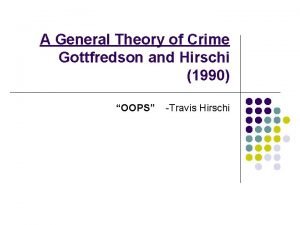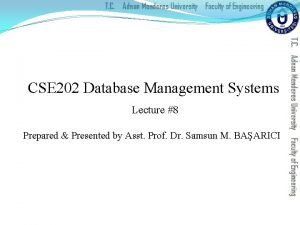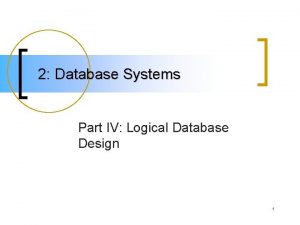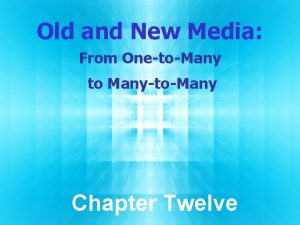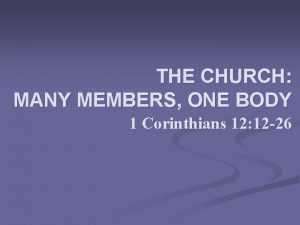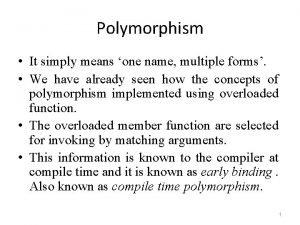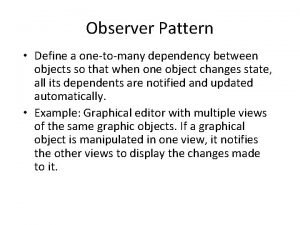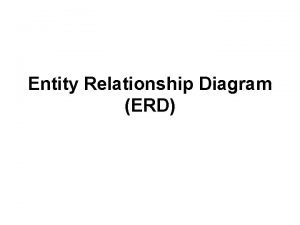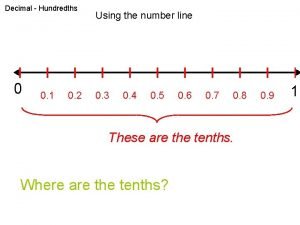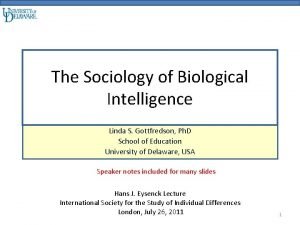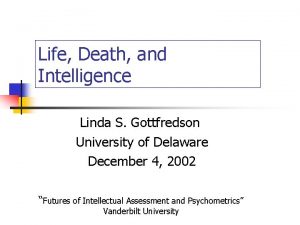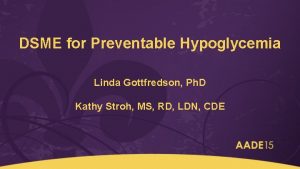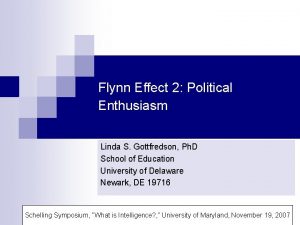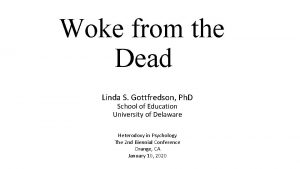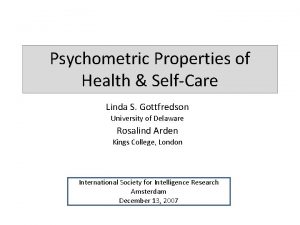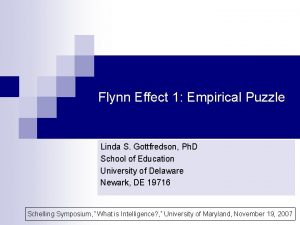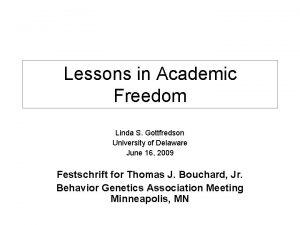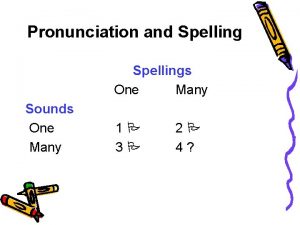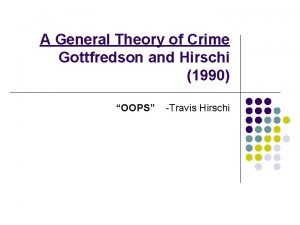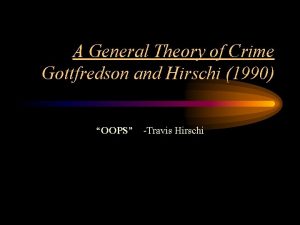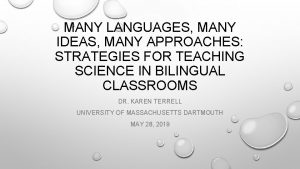Intelligence One or Many Linda S Gottfredson School




































- Slides: 36

Intelligence: One or Many? Linda S. Gottfredson School of Education University of Delaware APA 2006 New Orleans

4 Theories Agree: An “intelligence” is a very broad, important, and enduring ability Maybe agree: Intelligences are potentials for later achievement Disagree: How broad and content-specific “intelligences” are Number Name Content domains 7+ Multiple intelligences “Psychobiological potential to solve problems or fashion products that are valued in at least one cultural context” Gardner, 1983 3 Triarchic 1 g (~IQ) 0 Specificity Sternberg, 1985 Spearman, 1904 Jensen, 1998 Guilford, 1967 Linguistic Spatial Bodily-kinesthetic Logical-mathematical Musical Interpersonal Intrapersonal “Process domains” Analytical Creative Practical General facility for learning and reasoning in all domains g factor Many specialized abilities with narrow domain coverage 150+

Which One Should Psychology Teach? 1. Which is most accurate, and how do we know? • 4 hypotheses/counter-hypotheses (of many) 2. What, then, should we teach? 3. How can we best teach it?

Common Impressions • For “one intelligence” – People who do well on one test tend to do well on all others – Some people are “faster” learners than others • For “multiple intelligences” – People tend to be stronger in some areas than others (verbal vs. quantitative, etc. ) – There are different kinds of prodigies and geniuses

Large Network of Evidence Personal traits Biological origins Social outcomes

Large Network of Evidence Personal traits • Abilities • Personality • Social class • Race, sex, age • Health • Education • Etc. Social outcomes • Occupation level • Income • Job performance • School performance • Health/longevity • Law-abiding • Etc. Today’s illustrations Biological origins • Brain physiology • Genes • Health • Nutrition • Prenatal conditions • Etc. Guiding question: Which theory is most consistent with, best explains, and is least often contradicted by the totality of evidence?

My Unintended Journey Begins: Helping Career Counselors Help Clients (1980 s) Personal traits Social outcomes • Social class • Interests Job level OK, but what abilities do jobs require? ? Biological origins R I A S E C Field (Holland type)

First Step in My Journey (Pre-MI) Personal traits Social outcomes • Social class • Interests Job level R I A S E C Biological origins Different abilities needed? Field (Holland type)

My Analyses of Labor Dept. Job Aptitude Profiles Personal traits Social outcomes • Social class • Interests Aptitude Demands Spatial Verbal Psychomotor IQ R I A S E C R R C Biological origins Results: IQ more important in higher jobs (in all domains). Narrower abilities useful in certain content domains.

Converging Evidence on IQ’s Import (Employment Test Studies) IQ predicts better in higher jobs . 8 IQs of applicants for: Attorney, Engineer Teacher, Programmer . 5 Secretary, Lab tech Meter reader, Teller Welder, Security guard . 2 Packer, Custodian Higher-level jobs draw higher-IQ workers 80 100 120 IQs: Middle 50% 108 -128 100 -120 96 -116 91 -110 85 -105

Converging Evidence for Limited Import of “Broad” Abilities (More Test Studies) • Broad cognitive abilities (spatial, verbal, math, etc. ) – Don’t predict much better in own domain than others – Don’t add much to IQ’s prediction, either singly or all together • Same for performance in: – Jobs – Job training – School subjects Inference: One general ability dominates all the narrower ones.

Counter-Hypothesis #1 (Sociology, 1970 s) • Higher IQ does not have functional value, because – Employers favor high IQ because they are irrational or favor “their own kind. ” – Most job performance research relies on subjective ratings by supervisors. – IQ measures social class, not “merit. ” “Intelligence” is a smokescreen for justifying privilege. • How would you test this hypothesis?

Counter-Hypothesis #1 (Sociology, 1970 s) • It would predict that: – IQ predicts supervisor ratings better than objectively measured job performance Results? —just the opposite – Work in high-level jobs is not more cognitively demanding (job analysis data) Results? — the higher the job level, the more complex the work – analysis, reasoning, decision-making, updating knowledge, self-direction, change and ambiguity vs. – set procedures, routine tasks, much supervision, physical demands No evidence here against a “one-intelligence” theory

Counter-Hypothesis #2 (1980 s MI Theories) • Multiple intelligences exist, but Western society rewards only one. False: Most are not – IQ tests are paper-and-pencil tests – Paper-and-pencil tests privilege linguistic (Gardner) or analytical (Sternberg) intelligence True, but – Other cultures value other achievements not measured by those tests not the issue; • How would you test this hypothesis? Wrong reasons, but still a good hypothesis. potentials are.

Counter-Hypothesis #2 • It would predict: – – You will find them if you try to assess them They will be mostly independent of each other There will be no superordinate general intelligence IQ will coincide with one of the multiple intelligences • To verify, we need: – – Ways to measure the proposed intelligences Have people take those tests Have them take IQ test at the same time Observe that different intelligences don’t correlate much with each other or IQ tests

Constraints & Options in Testing It Bad • No tests available for Gardner’s MIs • STAT test for Sternberg’s Triarchics, but not much data Good • But many hundreds of studies with other tests • Those tests quite varied in nature • Effort in mid-century to create tests that don’t correlate • John Carroll (1993) reanalyzed all this evidence!

Results: Many Mental Abilities, but All Systematically Related • • • All abilities correlated Differ in generality (scope) Only one at apex (g) g is backbone of all others Broad abilities (II. ) are “flavors” of g Stratum g ≈ IQ III. I. V Q S M others

All Theories on Same Map Best guesses: Sternberg’s Triarchic (see Brody, 2003) Gardner’s MI (see Carroll, 1993). A Triarchic Multiple intelligences P g Non-cognitive strengths C 5 1 2 3 4 Other 7 6

Counter-Hypothesis #3 • IQ/g is just a narrow academic ability – IQ tests were created to measure academic ability – IQ items can’t measure practical or creative abilities • well-defined, with one right answer • decontextualized, and of no intrinsic interest – “Virtual simulations” needed for non-academic abilities • How would you test that?

Counter-Hypothesis #3 • IQ/g is just a narrow academic ability – IQ tests were created to measure. Yes, academic ability but a non-sequitur – IQ items can’t measure practical or creative abilities • well-defined, with one right answer Plausible, let’s check • decontextualized, and of no intrinsic interest – “Virtual simulations” needed for non-academic abilities • How would you test that? Prior studies of practical tasks say not—all tapped mostly g despite their intent not to • Adult functional literacy • Health literacy • Army simulations of actual work

Recall: IQ Predicts Better in Less Structured Jobs g Social outcomes • Standardized academic achievement • Job performancecomplex job IQ Biological origins Health self-care is also a complex, unstructured job . 8 • Years of education • Occupation level . 6 • Job performancemiddle level job . 5 • Income . 3 -. 4 • Law-abidingness • Job performancesimple job . 25. 2 • Happiness ~. 0 (? )

Complexity: How IQ Tests (and Life) Tap g IQ items require Number series 2, 4, 6, _, _ 1, 3, 6, 10, _, _ Similarities dog-lion air-water LIFE!

Planning, Spotting Problems

Impact of g Varies, But Is Pervasive Head wind IQ Tail wind

High-IQ People Make Life More Complex for Everyone

Counter-Hypothesis #4 • The hierarchical structure is an artifact of (a) the kinds of tests used, (b) factor analysis, or (c) Western culture. – It is “socially constructed. ” – It is not writ in the genes. – The brain has different modules corresponding to the MIs. • Behavior genetics provides a test: – Do broad abilities overlap because they share the same genetic roots? (genetic covariance analysis, say, using twins)

Results: Prime MI Suspects Are Mostly Genetic g G genes C C shared environments G U non-shared environments U ++++ + g (adults) ++++ verbal spatial + + G C U G +++ speed memory ++ C U ++ G C U G ++ C U

Genetic Overlap With Outcomes Too g Social outcomes h 2 % h 2 shared (heritability) with g • Standardized academic achievement • Job performancecomplex job • Years of education 60 -70% two-thirds • Occupation level 50% half IQ 80% Genetic roots • Job performancemiddle level job • Income • Law-abidingness • Job performancesimple job • Happiness 40 -50% half

Same Being Found for Brain g Social outcomes h 2 % h 2 shared (heritability) with g • Standardized academic achievement • Job performancecomplex job • Years of education 60 -70% two-thirds • Size • Occupation level 50% half IQ 80% Genetic roots • White matter • Job performance • Grey matter middle • level job speed Nerve • Etc. 40 -50% • Income • Law-abidingness • Job performancesimple job • Happiness half

Other Evidence Dovetails Personal traits • Abilities • Personality • Social class • Race, sex, age • Health • Education • Etc. Biological origins • Brain physiology • Genes • Health • Nutrition • Prenatal conditions • Etc. Social outcomes • Occupation level • Income • Job performance • School performance • Health/longevity • Law-abiding • Etc.

Current Place in My Journey? • Interim judgment – g theory: better tested, more consistent with totality of evidence – MIs probably known traits, some outside the cognitive realm – Triarchics: all mostly g • Current steps – Cognitive demands in preventing and managing accidental injury and chronic disease – Pedagogical demands in communicating the science

What, Then, Should We Teach? • Evidence matters – Anecdotes don’t count – Single studies rarely do – Robust, replicated patterns matter most • Weight of evidence matters – Explanations must go head-to-head – Practice healthy skepticism – Listen hard to other side (especially when you don’t want to) • Is ≠ ought; ought ≠ is – Facts reveal moral choices, not make them

What, Then, Should We Teach? • Focus on strata most relevant to your purpose – Explaining social inequality? III. (g) – Career counseling? II. (but can’t ignore III. ) – Skills training? I. (but can’t ignore III. ) • What we don’t yet know – – – Specific genes and environments that affect broad abilities Neural basis of g Why shared family influences on IQ vanish with age Why IQ scores have been rising in recent decades How to raise low IQs permanently Whether results hold in all times, places, extremes Surprising puzzles

How Should We Teach It? • Clear underbrush of confusions & misconceptions – – – IQ is rank within age, not raw horsepower Phenotype vs. genotype Genetic does not mean fixed (it limits elasticity) Intelligence is useful tool, not human worth IQ differences not “against the Declaration of Independence” • Anticipate emotion, urge to self-censor – Be matter-of-fact – Set up debates on policy implications (the “mights” & “oughts”) – Make classroom safe and civil • Push to dig beneath the surface – “What’s behind that label? ” – “Change one fact and probe the consequences” – “Spy the implicit message: God words & devil words”

How Should We Teach It? • Have bag of tricks for clarifying new concepts – Mental manipulation (what is g) – Task complexity (what calls it forth) – Heritability/environmentality • Explore g in everyday life (Open the black box) – Functional literacy items – Spotting hazards – Managing a chronic disease • Explore its limits (Other things matter, too) Give g its due, but put it in its place

Thank You • gottfred@udel. edu • www. udel. edu/educ/gottfredson
 Linda gottfredson
Linda gottfredson Gottfredson and hirschi
Gottfredson and hirschi Super ginzberg
Super ginzberg Anna roe kimden etkilendi
Anna roe kimden etkilendi One futureworld
One futureworld One god one empire one emperor
One god one empire one emperor One one little dog run
One one little dog run One king one law one faith
One king one law one faith Byzantine definition
Byzantine definition Ford one plan
Ford one plan See one do one teach one
See one do one teach one One price policy
One price policy Night structure
Night structure See one do one teach one
See one do one teach one Asean tourism strategic plan
Asean tourism strategic plan Asean one vision one identity one community
Asean one vision one identity one community During early teens, what is reasoning like?
During early teens, what is reasoning like? Perfect competition 4 conditions
Perfect competition 4 conditions Er diagram many to many
Er diagram many to many Bookstore database design
Bookstore database design Are the glue that holds the entities in the erd
Are the glue that holds the entities in the erd Unary many to many
Unary many to many Erd film
Erd film Unary many to many
Unary many to many Many-to-many communication
Many-to-many communication Sqlbi many to many
Sqlbi many to many Example of unary relationship
Example of unary relationship Many sellers and many buyers
Many sellers and many buyers 1 body church
1 body church One name multiple forms refer to
One name multiple forms refer to Plato theory
Plato theory Naipaul one out of many
Naipaul one out of many One body many parts
One body many parts Observer pattern sequence diagram
Observer pattern sequence diagram One god many forms
One god many forms Erd plus
Erd plus How many hundredths are in one tenth
How many hundredths are in one tenth

